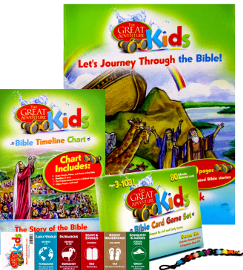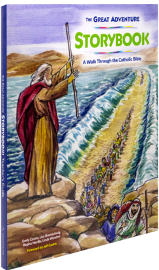Jeff Cavins began teaching “The Great Adventure”* many years ago as a way to introduce adult Catholics to the story of salvation history as told through the Bible. He identified what he believes to be the key narrative books in the Bible that convey the essential storyline that flows through the entire Bible. Cavins then uses those books of the Bible to tell the story of salvation in a way that is easy to understand. Those key books are Genesis, Exodus, Numbers, Joshua, Judges, 1 and 2 Samuel, 1 and 2 Kings, Ezra, Nehemiah, 1 Maccabees, Luke, and Acts. Later, Mark Hart adapted The Great Adventure into a format for teens called The Teen Timeline Course. Now, The Great Adventure Storybook: A Walk Through the Catholic Bible has adapted it for children in kindergarten through eighth grade.
The Great Adventure Storybook is a full-color, beautifully illustrated, softcover book. The story of salvation history can be presented using only this one book and a Bible, although there are other optional components that I will describe later. The book does not assume that parents are familiar with the Bible. It explains the contents and arrangement of the Bible and how to look up passages. This makes it a great resource for parents who want to start exploring the Bible for themselves as well as for those who are already familiar with it.
The Great Adventure Storybook has 205 pages, so it is not a short storybook. It has 24 chapters, but these are not chapters that you can read in one sitting. Each chapter has about six stories written at a level that even kindergartners should be able to understand. A Bible Reading Checklist at the beginning of each chapter shows the books or passages from the Bible that should be read along with each of the stories. The idea is that you will read a book or passage from the Bible, then read the story from the storybook that tells the same story in a summarized fashion, emphasizing the main ideas.
You will typically read one chapter (or the selected verses) from the Bible along with one story from the storybook in each sitting. If you have kindergartners, you might read only from the storybook.
There are three thought-provoking discussion questions at the end of each chapter, but since you and your children will probably come up with your own questions as you read, you might not use the end-of-chapter questions.
The Great Adventure Storybook and most of its optional components use the same color coding and symbols that are used in the adult and teen courses. Twelve different colors and symbols are used to indicate twelve key periods of biblical and church history as identified by The Great Adventure approach. The pertinent color and symbol for each time period show up in the right-hand border of each two-page spread.
The storybook pages include other symbols in the margins that you might use for further discussion. There are symbols for the six covenants in the Bible─the agreements that God made with one or more persons such as His covenant with Abraham. A symbol of a banner with a portion of the Nicene Creed indicates a passage in the story that relates to a statement in the Nicene Creed. A cross symbol identifies the biblical basis of one of the seven sacraments. A rosary bead symbol indicates where one of the mysteries of the Rosary shows up in the Bible. In addition, the text uses a bold and italicized font to indicate passages from the Bible that are used in the Mass. All of these symbols and words are also listed together in an appendix toward the end of the book.
Within the text of the book, some terms are in only a bold font. These are defined in a glossary that is found just before the appendix. Concepts that are explained more thoroughly in the Catechism than in the Bible have the Catechism location number in parentheses. These terms and concepts, too, might be used for further research or discussion, especially with older children.
 Forty-nine of the illustrations that are in the storybook are reprinted as black-line drawings for children to color in The Great Adventure Kids: Bible Story Coloring Book. Other supplemental items for The Great Adventure Kids Storybook are a Bible Timeline Chart, a Bible Card Game Set, color-coded Prayer Beads, and a bookmark.
Forty-nine of the illustrations that are in the storybook are reprinted as black-line drawings for children to color in The Great Adventure Kids: Bible Story Coloring Book. Other supplemental items for The Great Adventure Kids Storybook are a Bible Timeline Chart, a Bible Card Game Set, color-coded Prayer Beads, and a bookmark.
The accordion-style timeline chart gives students a visual aid to understand when biblical events happened. The card game set has 80 cards (each with illustrations and information) for playing six different games that help children remember what they are learning. And the prayer beads are a mnemonic tool for recalling the periods of biblical history covered in the book.
Summary
The Great Adventure Storybook can be used with all of your children together or one-on-one. It can be a part of your curriculum that is used on a regular basis, or it can be used whenever it fits into the family schedule. However you use it, this is a great way to introduce children to the story of salvation history.
* The Great Adventure course for adults has been renamed The Bible Timeline: The Story of Salvation, and a briefer version of it is titled Unlocking the Mystery of the Bible.












